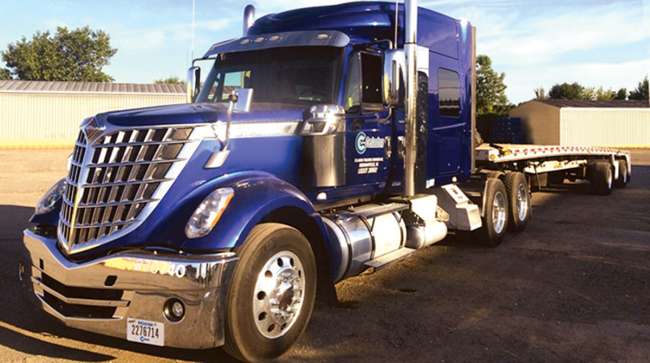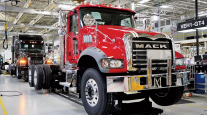Staff Reporter
Class 8 Orders in July Sink to Lowest Level Since 2010

[Stay on top of transportation news: Get TTNews in your inbox.]
Class 8 orders were down to their lowest level since 2010 in July, according to ACT Research.
North American Class 8 orders came to 10,200 units compared with last July’s all-time monthly high of 52,400; and down 21% from June.
The 10,200 units were also the lowest monthly order tally since February 2010, according to Columbus, Ind.-based ACT.

Vieth
“Weak freight market and rate conditions across North America and a still-large Class 8 backlog continue to bedevil new Class 8 orders,” said Kenny Vieth, ACT president and senior analyst. “Though, with original equipment manufacturers opening their new model-year order books in June and July, order weakness is increasingly the story of an over-capacitized Class 8 fleet.”
Steve Tam, ACT Research vice president, told Transport Topics that July tends to be the weakest month for orders, and usually runs 15% below normal months. Still, the numbers indicate increasing uncertainty about President Donald Trump’s trade policies and the economy in general. Stock markets have been reacting nervously to news about turmoil in the wake of pro-democracy protests in Hong Kong.
“We have uncertainty in the market,” said Tam. “It’s not just tariffs.”
Tam said the uncertainty causes “analysis paralysis,” meaning trucking firms put off buying new trucks while they consider how the economy is going.
Another research firm, FTR of Bloomington, Ind., reported preliminary North American Class 8 orders for July were 9,800 units, falling below a 10,000-unit threshold that has not been breached since 2010, FTR officials said in a news release.
“Despite most order boards being opened for 2020 build slots, carriers appear in no rush to grab production capacity,” FTR officials said. “July orders were 24% below an already soft June with a negative 82% year-to-year comparison. Class 8 orders for the past 12 months have now fallen to a total of 288,000 units.”
RELATED: July Class 8 Sales Top 25,000 for Year’s Highest Volume
FTR said fleets continue to take a wait-and-see approach to 2020 equipment.
“Potentially higher equipment costs, uncertain demand, and enough available capacity in the market are keeping order activity at bay,” said Jonathan Starks, FTR chief intelligence officer.
One major truck manufacturer said the trucking economy has cooled since the highs of 2018.
“After a period of record-level orders in 2018 and early 2019, we are seeing the market enter a phase of normalization at very healthy levels,” Richard Howard, senior vice president of sales and marketing for Daimler Trucks North America, told TT. “We expect a continued positive development in sales for the coming months and into 2020. Customer interest in our Class 8 on-highway offerings remains high, particularly as we work hand-in-hand with our dealers to introduce the all-new 2020 Freightliner Cascadia.”
But deterioration in the used-truck market in the last several weeks has caused some large fleets to re-evaluate or possibly delay orders for new Class 8 sleeper trucks, said Neil Frohnapple, director of equity research at The Buckingham Research Group. Fleets like to trade in their older trucks when the market for them is hot.
“(The market) is less favorable to them,” Frohnapple told TT. “We saw this in 2015. (Fleets) started delaying orders for new trucks.”

Feight
Preston Feight, CEO of Paccar Inc., told investors in July that fleets that use trucks from his company are uniquely positioned to do well even in a tough used-truck market, as they consider new Class 8 units.
“One of the nice things about being part of Paccar is our trucks do command a 10% to 15% premium in the market and as we’ve watched our market share grow over the past several years, we’ve invested in creating a great used-truck capability, a selling capability,” Feight said in a conference call. “We have a fantastic dealer network that does a good job of managing used trucks and distributing used trucks to customers. So between our premium position and our capability, we feel like we’re in a good space.”
And at least one major firm has plans to go ahead now and replace 2,000 trucks. Celadon Group of Indianapolis said it plans to replace 2,000 tractors in the next several quarters.
Paul Svindland, Celadon CEO, said with the company’s new infusion of $165 million of investment cash, the company can move on to the next round of improvements and begin to replace 2,000 tractors that are 4 and 5 years old.
“Our fleet refresh is underway, with approximately 100 new trucks delivered since May, another 100 scheduled for August, and approximately 1,800 more expected to arrive over the next several quarters,” Svindland said July 29. “These new trucks will dramatically lower our costs, enhance productivity, and improve the lives and safety of our professional drivers.”
Celadon ranks No. 38 on the Transport Topics Top 100 list of the largest for-hire carriers in North America.




